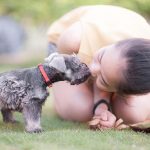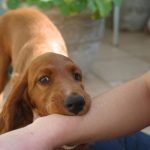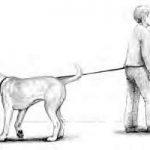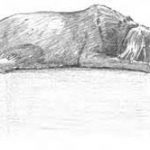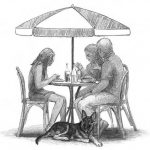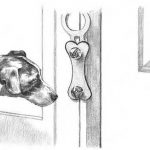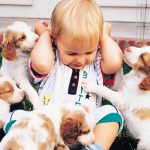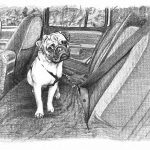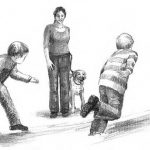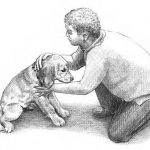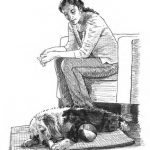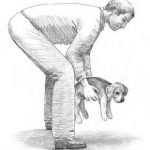Using Cool Tools and Groovy Gadgets
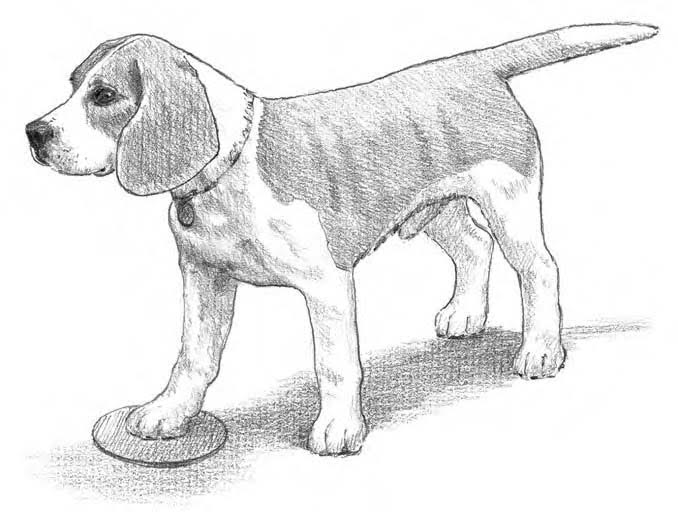
In This Chapter
- Training your puppy with positive reinforcement
- Using treat cups and snack packs as training devices
- Discovering clicker-based training
- Improving communication with targeting and point training
Believe it or not, you can solve more problems with positive feedback than with discipline. I’ve used every technique in this chapter, often simultaneously, and I guarantee that these fun approaches are more effective. By creating an atmosphere in which cooperation is fun and learning is natural, your puppy’s days will be stress-free and her reactionary mischief almost nonexistent. I’m as eager to share this information as, I’m sure, you are to discover it.
Using Positive Reinforcement to Encourage Happy Cooperation
Remember
The one highlight that makes a puppy’s day complete is your interaction with her. Dogs like being plugged into group activities. They want to know what’s going on and want to be included in your thought process. Puppies are sharply aware of what behaviors get a reaction, and they quickly adapt their behavior according to your behaviors and routines.
Remember
Whatever puppy behaviors you pay attention to, you reinforce. Focus on a good dog, and that’s what you’ll have. Get carried away with the negative, and you’ll have a horror show.
Tip
If your puppy has already developed bad habits, use Chapter Dealing with Daily Hassles to reorganize your environment, discourage her interest, and restructure her activities to ensure that all her needs are met.
Emphasizing Good Habits with a Little Indulgence: Treat Cups and Snack Packs
Treat cups
Tip
Have children? Make it a family project by decorating your treat cups with construction paper, markers, and stickers.
Using treat cups for problem solving and conditioned learning
Making an object exchange with a treat cup
Remember
Shaking a treat cup and encouraging your puppy to share will teach her only one thing: to bring you what she’s found, undestroyed. Focus positively on her objects, and that’s what she’ll settle for in the end.
Treat cup fun and games
Tip
Use your treat cup to play fun, recreational learning games, such as the following:
– Runaway-Come Game: Shake the cup as you run away from your puppy. Shout her name cheerfully as you run away and say “Come” as you treat her for being near you.
– Treat Cup Name Game: Send your puppy back and forth between two or more people. Use her name as well as each person’s. Soon your puppy will know everyone on a first-name basis, including herself!
– Quick Sit Game: Shake the cup and position your puppy into the sit position. Soon she’ll be conditioned to sit quickly each time she hears the cup being shaken — and no words will be necessary. When your pup has mastered the Quick Sit Game, use it when company arrives.
Snack packs
Warning!
Saying “Good dog!” repetitively in a high-pitched tone may create so much excitement that your puppy may abandon her good behavior for something more recreational, such as nipping or jumping. If you’re using a clicker, click before you treat. If you’re not using a clicker, use a sharp, marking word like “Yes” or “Good” to highlight the exact behavior you want your puppy to repeat.
Am I supposed to feel like a Pez dispenser?
Remember
If your puppy charges you or blocks your path, ignore her. Look away and walk on. If she barks or whines incessantly, don’t cave. Also, don’t use any eye contact or physical interaction. If she paws at you, don’t dole out any snacks or attention. If she’s prancing through the living room with your undergarments, ignore her and leave the room. After enough mischievous behavior she’ll finally sit or collapse in exhaustion. And when she does, reward her! She’ll catch on quickly to what you expect from her.
Tip
No rules say that your puppy can’t work for her meals. I used to walk my puppy with her breakfast in my snack pack to highlight her off-lead cooperation. When time allows, place half or more of your puppy’s meal in your snack pack and run through familiar exercises or directions.
Conditioning your pup to come to you naturally
Clicker-Happy Training
“Photographing” the moment
Tip
To get the most out of the click-treat combination, work on your timing. Click the very instant your puppy accomplishes a task (such as “Sit” or “Down”) or during a time when she’s behaving well.
Remember
The click-treat formula is one click, one treat. Any other formula would be inconsistent, and inconsistency is too confusing for your puppy. If she makes a gigantic breakthrough, you can give her a handful of treats, a so-called jackpot, but use only one click to highlight her cooperation.
Click and treat: Married for life
Clicker specifics
Around-the-clock reinforcement
Tip
If you want to use the clicker throughout the day, attach it to a bracelet key chain or a lanyard around your neck. Stuff your pockets or your snack pack with goodies so that you’re never without them, and click and treat away.
Clicker-happy lessons
Remember
If you decide to use this approach, set aside time to do between one and four ten-minute clicker lessons per day. Focus on one or two skills, and click and treat any cooperation.
Top ten clicker-happy associations
– Name: Call out your puppy’s name. If she looks to you, click and treat. If not, ignore it and move on.
– Sit: Each time you expect civility, encourage your puppy to “Sit.” Some preferred times of civility include before you give her a treat or toy, before you toss a stick, and when entering and exiting the home. Click and treat the instant her bottom hits the floor.
– Housetraining: Click and treat the moment your puppy eliminates in the right spot.
– Down: Using the techniques described in Chapters Training through Your Pup’s Growth Stages and Graduating to Off-Lead Control, guide your puppy to lie down. Click and treat the moment her elbows hit the floor, and say “Down” as she lowers herself into position.
– Greeting: When greeting your puppy, ignore her until she’s sitting at your side or until she fetches a toy. Reward both behaviors with an instant click and treat.
– Give or Drop: To help your puppy learn to spit out toys or other objects on cue, hold out a treat when she has something in her mouth. Say “Give” and click and treat the instant she spits it out. If she debates the issue, use a more tantalizing tidbit.
– Come: If you want your puppy to return to you reliably, click and treat whenever she’s nearby. With this click and treat combo, she won’t stray far.
Warning!
Rewarding a puppy for being nearby is different from trying to lure your puppy to come to you. Though many have tried to use the clicker to entice their puppy to come, the cooperation is short lived — especially when the temptation to stray is stronger than the temptation to snack.
– Extinguishing impulse chasing: To discourage your puppy from chasing your children, cats, or other temptations, use the leash corrections found in Chapter Kids and Puppies, and then use the click and treat association to refocus her attention on you.
– Contained barking: No one minds when a puppy barks a little, but when it turns bratty or incessant, well, that’s another story. Use the click and treat method to reinforce your puppy’s alert barking and arrest any ongoing chatter with a quick tug of the leash (Chapter When Anxiety Strikes goes into more detail about how to handle an overly talkative puppy).
Tip
Pay close attention to your timing when encouraging your puppy to quiet down. If you click when she’s merely taking a deep breath or a long pause, your click and treat combo will only inspire more ruckus. Wait until your puppy has fully quieted down and is focused on you to reward her cooperation.
– Settled down and chewing a bone or toy: Ah, finally a moment’s peace: Your puppy is settled down and is quietly chewing a bone. Now is the time to lavish her with attention and praise. For Pete’s sake — this is a moment to highlight.
Phasing out the clicker
1. When introducing the first direction, “Sit,” use continual reinforcement for a week — click and treat each time you say this direction.
You may use your treat to lure your puppy into position, but you’ll begin to witness your puppy’s quick association. In fact, soon all you’ll have to do is show her the clicker or the treat and she’ll sit automatically. That said, you may also notice that your puppy is less focused if the clicker and treats are absent.
2. After a week of reinforcing the “Sit” direction, introduce another direction, such as “Down,” with continual reinforcement. At the same time, you should begin to phase out using the clicker with the “Sit” direction by replacing the click and treat with verbal praise.
Don’t stop using the clicker with “Sit” cold turkey. Instead, vary the clickand-treat reinforcement with praise. For instance, click and treat two responses, and then go two or three with praise only. Click and treat three in a row, and then praise the next one. Over a week’s time, tip the scale: Click and treat one, praise three. Within two weeks, your verbal appreciation will be incentive enough for your pup to continue the good behavior.
Tip
As you phase out the continual reinforcement phase of a specific direction, introduce continual reinforcement at other times throughout the day, such as before you feed your puppy, toss toys, or give her a bone. Light bulbs will start blinking, and your puppy will associate this direction with praise and rewards.
Remember
As you phase out the clicker, don’t forget to praise your puppy. Eventually, when all the lessons are understood, you’ll shelve the clicker, and the only thing motivating your puppy’s good behavior will be the sound of your voice.
Targeting
Table 11-1 | Targeting Skills | ||
Type of Training | Skill Puppy Must Use | Tool | Lessons |
Point training | Focusing | Your finger | All obedience directions and “Go to” (a person or object) |
Target training with a wand | Following | Targeting wand | All obedience direc tions and “Go to” (a person or object) |
Target training with a stationary disc | Standing; staying | Targeting disc | Stationary directions such as “Stay,” “Wait,” “Go to” (bed or crate), and “Go out” |
Remember
The concept behind targeting is simple: Using verbal and food reinforcements, you teach your puppy to move toward the point of your finger, a handheld wand, or a stationary target (which can be anything from a lid to an index card or a book of matches). Used separately or in unison, these tools encourage your puppy’s interaction and help you highlight her cooperation the moment it happens. With these simple skills, the sky is the limit.
Point training
Remember
To teach your puppy point training, you have to follow three phases (shown in Figure 11-2a–c) in order to achieve your end result (shown in Figure 11-2d). The first two phases use food as an incentive, and the third works to wean the pup off treat dependence. The whole process takes ten days to two weeks.
Phase 1: Instant gratification
1. Place or line up ten treats on a high table. Use either a clicker or marker word (such as “Yes”) to highlight the moment your puppy alerts to the point of your finger.
2. Point your index finger straight to the floor, and curl your other fingers into your hand.
3. Tuck one treat into the palm of your hand.
4. Hold your pointed index finger 3 inches from your puppy’s nose.
5. When she reaches out to touch your finger, say “Yes”, and then click and treat by flipping your hand around to reveal the snack.
6. Repeat this simple exercise until all the treats are gone.
Tip
Keep the lessons short and snappy, practicing one to four times each day for five to ten minutes.
Phase 2: Delayed gratification
Phase 3: Gradually phasing out treats
Targeting wands
Remember
Think of a targeting wand as an extension of a point. You can use a kitchen utensil, metal office pointer, or tent pole. Pick your tool, and teach your puppy to mark the end by rewarding her interest. Follow these similar steps as discussed in the point training section:
1. Point the end of the wand to the floor and hold it inches from your puppy’s nose.
2. The second your puppy reaches out to sniff it, say “Yes” and then click and treat.
3. Continue simple touches until your puppy’s reaction is familiar and reliable. Then vary the distances and the angle of the wand.
4. Increase the number of touches between rewards and increase the directional cues to include the following:
- “Let’s go”: Hold the wand next to your side and give this direction as you walk along.
- “Go to”: With a partner, direct your puppy back and forth between the two of you using the “Go to” direction. Two target wands may be used.
- “Down”: Signal “Down” as though your target stick were an extension of your finger. In this case, the targeting wand allows you to increase the distance between you and your puppy.
- “Follow”: Use this direction when teaching your puppy to move away from your side. This cue is ideal for confidence-building exercises and off-lead adventures, such as agility, pet therapy, and competition obedience.
- “Come”: A targeting wand is an ideal attention-getting and directing tool for off-leash, distant comes.
Targeting discs
1. Place a disc on the floor.
2. The moment your puppy shows interest in the disc — even so much as a sniff — say “Yes” and click and treat.
Continue this association until her interested is piqued when she sees the disc.
3. Then wait until she touches the disc with her paw (see Figure 11-3) to reward her interest.
Remember
It may take some time initially, but you need to wait for her to figure it out. Positioning her foot doesn’t lead to understanding and may have the reverse effect. The moment she steps on the disc, say “Yes” and click and treat. Gradually increase her understanding until she steps on it with her entire paw.
4. When your puppy comprehends the task, repeat it often to cement her understanding. Begin to associate the word “Disc” with this behavior.
5. Now begin to move the disc between sequences.
Practice three moves per lesson.
6. The moment your puppy steps on the disc, instruct her to “Wait.” As she cooperates, use a lightweight leash or short leash to steady her as you introduce familiar directional cues.
Start with stationary directions like “Sit” and “Down.” If your puppy is familiar with “Stay” use it, too. Gradually increase the time you expect your puppy to be still.
7. Position the disc increasingly farther from your side.






